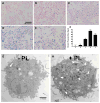A comprehensive analysis of transfection-assisted delivery of iron oxide nanoparticles to dendritic cells
- PMID: 23747738
- PMCID: PMC4031028
- DOI: 10.1016/j.nano.2013.05.010
A comprehensive analysis of transfection-assisted delivery of iron oxide nanoparticles to dendritic cells
Abstract
Polylysine (PL) has been used to facilitate dendritic cell (DC) uptake of super paramagnetic iron oxide (SPIO) nanoparticles for use in magnetic resonance imaging (MRI). In this work, we examined the effect of PL on cell toxicity and induction of cell maturation as manifested by the up-regulation of surface molecules. We found that PL became toxic to bone marrow-derived DCs (BMDCs) at the 10 μg/ml threshold. Incubation of BMDCs with 20 μg/ml of PL for 1h resulted in approximately 90% cell death. However, addition of SPIO nanoparticles rescued DCs from PL-induced death as the combination of SPIO with PL did not cause cytotoxicity until the PL concentration was 1000 μg/ml. Prolonged exposure to PL induced BMDC maturation as noted by the expression of surface molecules such as MHC class II, CD40, CCR7 and CD86. However, the combination of SPIO and PL did not induce BMDC maturation at 1h. However prolonged exposure to SPIO nanoparticles induced CD40 expression and protein expression of TNFα and KC. The data suggest that the use of PL to enhance the labeling of DCs with SPIO nanoparticles is a dedicated work. Appropriate calibration of the incubation time and concentrations of PL and SPIO nanoparticles is crucial to the development of MRI technology for noninvasive imaging of DCs in vivo.
From the clinical editor: The authors of this study present detailed data on toxicity and efficiency of polylysine-facilitated uptake of USPIO-s by dendritic cells for cell-specific MR imaging.
Keywords: Dendritic cells; Iron oxide nanoparticles; Nanotechnology; Polylysine; Transfection.
Copyright © 2013. Published by Elsevier Inc.
Figures





References
-
- Pham W, Kobukai S, Hotta C, Gore JC. Dendritic cells: therapy and imaging. Expert Opin Biol Ther. 2009;9:539–64. - PubMed
-
- Grolleau A, Sloan A, Mule JJ. Dendritic cell-based vaccines for cancer therapy. In: Samir Khleif., editor. Tumor immunology and cancer vaccines. 2005. pp. 181–205. - PubMed
-
- Mohty M, Olive D, Gaugler B. Leukemic dendritic cells: potential for therapy and insights towards immune escape by leukemic blasts. Leukemia. 2002;16:2197–204. - PubMed
Publication types
MeSH terms
Substances
Grants and funding
LinkOut - more resources
Full Text Sources
Other Literature Sources
Research Materials

